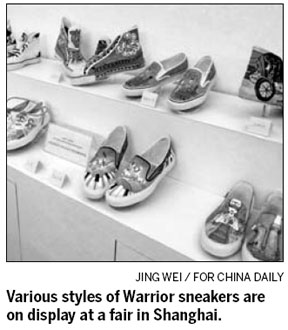A vintage shoe steps up and then down
Updated: 2011-10-17 14:58
By Raymond Zhou and Jin Huiyu (China Daily)
|
|||||||||||
At a national sports event in 1948, a helicopter flew over the Shanghai stadium, spewing out plumes of flyers. It was an ad for Warrior, a canvas shoe that started in that most metropolitan of Chinese cities in 1933.
Warrior was cool. Even its marketing gimmick was talk of the town.

Later on, when New China was founded, Warrior shoes remained the preferred choice of trendsetters, such as sports teams and soldiers, at a time when fashion was out of vogue. During the 1970s, loitering around town in a pair of Warrior sneakers was the Chinese equivalent of doing a disco dance in John Travolta garb. It epitomized urban chic, especially for young men.
Fast-forward a decade or two. The economic boom had drowned out many of China's vintage products. Warrior was still available, but mostly favored by grandmas for grocery shopping or grandpas for outdoor tai chi. It had turned into the antithesis of Nike or Adidas in public consciousness. Its price, as low as 12 yuan a pair at a street-side stall, reflected that.
"They used to sell for 10 yuan in the 1950s - at a time when most urbanites were making 30 yuan a month. It was considered high-end," recalled Gui Chenggang, the shoemaker's executive director.
For two decades, Warrior stayed in the doldrums of public neglect, dying a slow death. Then something magical happened. Warrior (and its brother brand, Feiyue's) shoes started turning up in Europe - in upscale boutiques and glossy fashion magazines. A pair fetched upwards of 50 euros ($69). Orlando Bloom and other cool dudes were spotted wearing them.
It turned out a Frenchman had bought batches and exported them to Europe. What Chinese at the time deemed uncool was retro chic to him - and to those influenced by his taste.
The spell he cast inevitably expanded to China. As reports of the brand's revival in Europe trickled back home, China's young overcame their initial disbelief and found a new passion for the almost 80-year-old brand. When a flagship store was opened last year, on the site of its old factory in Shanghai, 400 pairs flew off the shelf on the first day.
Now, Gui's task is to differentiate the fashion-seeking young who are attuned to Western-style marketing from the nostalgia-driven, budget-conscious old-timers, satisfying both customer segments without compromising brand integrity. He offers the classic style for less than 100 yuan ($16), and several times that price for one with customized hand painting.
"We felt lost before, but we never vanished completely. When we re-entered public view, the middle-aged and senior citizens felt it was near and dear. Some even demand their children be our customers," Gui says.
Gui believes Warrior has come a long way - from its initial branding as professional sportswear, later to fitness wear and then unexpectedly to fashion wear. The three overlap to some degree, but with different emphasis in different times.
"Our current positioning is to combine the retro classic with new trends - to appeal to the young demographic," he explains.
He adds that Warrior will continue marketing to the fitness segment but needs an extra push to get into the professional sports niche.